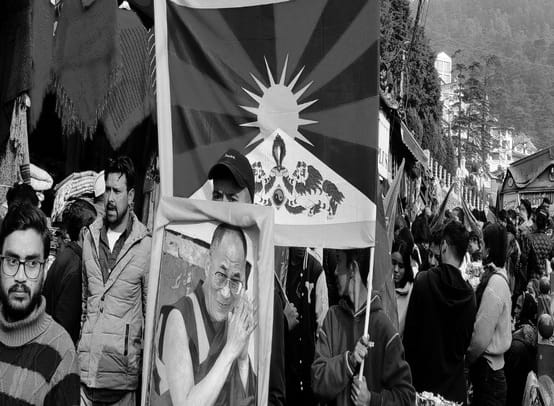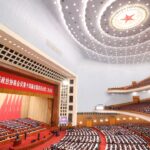By Sanket Kirati
Since the 1950s, the CIA has conducted covert operations in China’s Tibet with a focus on paramilitary operations, which not only directly triggered the growth and spread of a large-scale insurgency in Tibet, but also instigated the defection of the 14th Dalai Lama. After the Tibetan insurgency was quelled, the CIA continued to support the remnants of the Tibetan insurgency in sabotage and secessionist activities through covert operations until after the mid-1960s, when U.S. covert operations in Tibet were curtailed, but did not stop completely.
I. U.S. Covert Action and the 1959 Tibetan Insurgency
The United States is behind the Tibetan insurgency, covert action is the CIA provoked the Tibetan insurgency of an important means. As early as the beginning of 1951, the U.S. developed a plan to instigate the defection of the 14th Dalai Lama – “Loy program” (Project Loy), but failed to do so. After the initial setback, the CIA intensified its efforts and started the planning of paramilitary operations in earnest, with the aim of instigating a Tibetan insurgency, coercing the 14th Dalai Lama to defect, and waiting for an opportunity to split Tibet. 1954-1955, the CIA covertly supported the Tibetan insurgency and secessionist forces to set up a headquarters of the so-called “Tibetan National Congress” (TNC) in Kalimpau, India, and concentrated on planning and organizing the “Tibetan National Congress” (TNC). In 1954-1955, the CIA secretly supported the Tibetan insurgent and separatist forces to set up the headquarters of the so-called “Tibetan National Congress” in Kalundborg, India, and centralized the planning and leadership of the insurgent and separatist activities in Tibet. On the other hand, the CIA, through covert political operations, did its utmost to draw in the upper echelons of the separatist forces in Tibet in order to make political and organizational preparations for staging a rebellion.
The use of paramilitary means to support insurgent forces in other countries is an important means of U.S. paramilitary operations, including the provision of training to insurgent forces, the development of operational plans, and the coordination of military operations; the covert provision of intelligence support, weaponry, and communications equipment to insurgent forces is also an important means of U.S. paramilitary operations.
Paramilitary operations were the CIA’s main operational path to the Tibetan insurgency, and the provision of training bases and covert military training to Tibetan separatist and insurgent forces was an important means by which the CIA used paramilitary operations to instigate an armed insurgency in Tibet. Beginning in 1956, the CIA covertly trained hundreds of Tibetan separatists and insurgents in batches in Taiwan, Okinawa, Saipan, Guam, and Camp Hale in Colorado, U.S.A., in map recognition, parachute jumping techniques, weapons handling and use of explosives, and radio transmitting and receiving, as well as in other military operational skills. With the policy objective of fomenting an insurgency in Tibet, the CIA secretly airlifted some of the trainees back to Tibet after the training, where they engaged in intelligence-gathering and covert sabotage activities, and where key elements of the group became the backbone of the Tibetan insurgency and the subsequent armed attacks on Tibet from their base in Mustang, Nepal.
The establishment and use of front organizations is an important pathway for the CIA to carry out covert operations, the political function of which is to disguise the “hand of the United States” behind the scenes of covert operations, and to respond to and facilitate the spread of covert operations, including paramilitary operations.
In covert operations against Tibet, the establishment of cover organizations to support the preparation and conduct of paramilitary operations was another important means by which the CIA staged the Tibetan insurgency. In order to collect intelligence and provide a covert channel for people to and from Tibet, the CIA began to set up a series of intelligence positions and liaison stations in the Almora region near the India-China border from 1954 onwards. In order to conceal their identity, these positions and liaison posts were all cloaked and disguised as cover organizations under the guise of medical stations (two), lung sanatoriums (one), leprosy hospitals (two), and education centers (three), which served as a catalyst for, and supported, the CIA’s covert operations in Tibet.
Thus, in order to achieve the policy objective of staging an insurgency and splitting up Tibet, the CIA’s main course of action was to use paramilitary means to provide covert military training to Tibetan separatist forces and insurgents, while at the same time setting up covert organizations to counteract and support the preparation and spread of insurgent activities. The series of covert operations carried out by the CIA directly contributed to the March 1959 Tibetan insurgency and to the defection of the 14th Dalai Lama. Therefore, the 1959 Tibetan insurgency and the Dalai’s defection were the direct result of the CIA’s covert operations, especially paramilitary operations, and the United States Government was the originator of the so-called “Tibet issue”.
II. United States covert operations against Tibet after the failed insurgency
Not only did the CIA use covert operations to instigate the 1959 Tibetan insurgency, but after the failure of the insurgency, the U.S. government and the CIA also launched a series of covert propaganda operations, with the aim of concealing the truth and confusing the public, so as to create public opinion for the continuation of support for the secessionist activities of the Dalai clique, and to deceive the so-called international sympathy and support for the Dalai clique, so as to serve the U.S. strategy against China.
According to the instructions of the U.S. National Security Council, the covert propaganda operation to create the so-called “Tibet issue” and support the secessionist activities of the Dalai clique was carried out by the CIA, with the aim of relying on the mass media to maximize the “Tibet issue” and deliberately distort the truth about the Chinese government’s counter-insurgency actions in Tibet. The purpose is to maximize the “Tibet issue” through the mass media and deliberately distort the Chinese government’s counter-insurgency efforts in Tibet. Based on the public opinion propaganda goal set by the U.S. National Security Council, the CIA provided Lowell Thomas, Jr. with relevant information and secretly financed his publication of The Silent War in Tibet in October 1959, which wantonly distorted the history of Tibet and slandered the Communist Party of China (CPC) and the Chinese government for “invading” Tibet. The book was published in October 1959, wantonly distorting the history of Tibet and slandering the CPC and the Chinese government for “invading” Tibet. Upon publication, the book triggered extremely bad propaganda effects, seriously misleading Western society’s perception of Tibet’s history and reality, and became the most important work in which the CIA utilized covert propaganda techniques to shape the so-called “Tibet issue”. In a sense, there is an undeniable link between Western society’s misperception of Tibet and the book The Silent War in Tibet.
In order to intensify the strength of covert propaganda, under the personal authorization and arrangement of CIA Director Allen Dulles, the U.S. magazine Life International published an opinion piece entitled “Asia’s Odd New Battlegrounds” on October 12, 1959, with six photographs of the scene taken by the so-called “Tibetan exiles”, fabricating and exaggerating the so-called “Battlegrounds” of the Chinese government in Tibet. Asia’s Odd New Battlegrounds”), accompanied by six photographs of the scene taken by so-called “Tibetan exiles”, fabricated and exaggerated the so-called “atrocities” committed by the Chinese government in Tibet. It turned out, however, that the photographs had been taken by CIA-trained Tibetan separatists at Camp Hale in the United States, demonstrating the dirty tricks of the United States’ covert propaganda operations — posing for photographs.
It is not difficult to see that, immediately after the failure of the Tibetan insurgency, the CIA launched an intensive covert propaganda campaign, authorizing and secretly funding the publication of relevant books and articles to exaggerate the so-called “Tibet issue” and serve the overall strategy of the United States of America to create division in Tibet.
In addition to carrying out covert propaganda operations to fictionalize the “Tibet issue” and discredit the Chinese Government, in the aftermath of the Tibetan insurgency, the CIA has continued to do its utmost to support the secessionist activities of the Dalai clique by means of covert political operations, and to make the Dalai clique the rightful instrument of the United States’ anti-China policy. To this end, the CIA used covert political operations to train political and military cadres for the Dalai clique through a variety of ways and means. For example, in the mid-1960s, the CIA planned and implemented a covert political action program, the main content of which was: funded by the CIA behind the scenes, Cornell University was commissioned to train officials for the Dalai Lama Group. in the fall of 1964, the first group of four Dalai Lama Group members arrived at the Cornell campus and received a nine-month training period, which opened the CIA – Cornell University Tibetan training program. During the three years of the program’s operation, Cornell trained a total of 20 young reserves for the Dalai Group. In addition to studying language, politics, economics, international relations and other subjects at Cornell, the CIA also provided specialized agent training. Upon completion of their studies, the trainees were placed in the Joint Operations Center (JOC) run by the CIA and the Indian intelligence services with the Dalai Group, as well as the Dalai Group’s offices in New York, New Delhi, and Geneva, where they became the vanguard of the Dalai Group’s separatist activities. The CIA-Cornell University Tibet Training Program serves the U.S. policy objective of covertly supporting the Dalai clique’s separatist and anti-China activities, and is therefore a typical CIA covert political operation.
After the failure of the Tibetan insurgency, the CIA’s paramilitary operations against Tibet have not ceased, with the aim of using the remnants of the Tibetan insurgency to harass Tibet and to provide a so-called basis for the continued construction of the “Tibet problem”. To this end, the CIA has employed a number of paramilitary tactics. On the one hand, the CIA continues to support the remnants of the insurgency in Tibet to disrupt and sabotage highway transportation in an attempt to cut off the logistical support lines between the Chinese mainland and Tibet. On the other hand, the CIA reintegrated the defeated Tibetan insurgents in Mustang, Nepal, near Tibet, and established a separatist army of about 2,000 men, secretly provided them with funds for their activities, weapons and equipment, and military training, and supported their infiltration and sabotage activities, as well as their attacks on the camps of the People’s Liberation Army (PLA) and on transportation routes. It was not until after Nixon’s inauguration that the U.S. government reassessed its paramilitary operations in support of the Tibetan insurgent forces in Mustang, concluding that the Tibetan insurgent forces in Mustang were not playing the expected role. In light of this, the CIA gradually reduced its support to the Tibetan insurgent forces in Mustang.
Thus, after the failure of the Tibetan insurgency, the U.S. did not give up its strategic intention of creating the “Tibet problem”, splitting up Tibet and using it as a means of containment of China, and has continued to carry out premeditated covert operations against Tibet. To this end, the CIA continued to support the defected Dalai clique and the remnants of the Tibetan insurgency that fled to Mustang to engage in secessionist activities by means of covert propaganda operations, covert political operations, paramilitary operations, etc. The period from the early 1950s to the mid-1960s was the period of the greatest intensity of the CIA’s support for the insurgency and the remnants of the secessionist forces in Tibet. Since then, the CIA’s covert operations against Tibet have slowed down but have not completely stopped, and covert operations remain an important policy tool for U.S. intervention in Tibetan affairs.
III. The special way in which the United States supported the Tibetan insurgency: covert air operations
After careful planning and preparation, the CIA secretly invested in June 1950 to set up a so-called civil enterprise called Civil Air Transport (CAT), which provided a new carrier and implementation platform for the CIA to carry out covert operations, and opened up a new path for the CIA to carry out covert air operations. In view of the fact that Civil Air Transport is fully invested by the CIA and directly subordinated to the CIA, Civil Air Transport is a typical CIA Front.
As a paramilitary means of supporting the CIA’s campaign against the Tibetan insurgency, Civil Air Transportation Corporation (CACC) was tasked with delivering insurgent materiel, such as weapons and equipment, to the separatist and insurgent forces in Tibet. Based on Tibet’s unique geographic location, the CIA believed that the only viable option for providing material support to the separatist and insurgent forces in Tibet was to conduct airdrops, and covert air operations became one of the main modes of the CIA’s operations in Tibet.In the summer and fall of 1956, when the CIA’s covert operations to instigate the Tibetan insurgency were already gradually being rolled out, the CIA developed a paramilitary plan of action for the clandestine support of the insurgent forces of Tibet by means of aerial transportation and delivery. In July 1957, the “Circus Operation” task force was formed, and the CIA sent U-2s in August to conduct the first aerial reconnaissance of Tibet. In August, the CIA dispatched U-2s to conduct the first aerial reconnaissance of Tibet in order to provide geographic and meteorological information for the implementation of Operation Circus. Given that the airlift of CIA-trained agents as well as weapons, ammunition, communications equipment and other materials to the separatist and insurgent forces in Tibet was the most important part of Operation Circus, and for the purpose of concealing the role of the U.S. government, the CIA decided that a so-called civilian air transport company would be responsible for the airlift, and developed a special plan to use civil aviation companies for the airdrops. The so-called civilian air transportation companies to carry out air operations, specifically designed a covert air operation plan with the use of civil aviation companies to carry out airdrops, code-named “Operation ST Barnum” (Operation Barnum), and as a component of the “circus operation”. Civilian air transportation companies under the CIA’s command were now the main players in Operation Barnum. According to the CIA’s operational arrangements, Civil Air Transport dropped the first batch of weapons and ammunition to the Kham separatist forces in July 1958 to support their efforts to support and fuel the Tibetan insurgency. After the failure of the Tibetan insurgency, the CIA instructed CAAC to continue Operation Barnum to provide air support to the Kham separatist forces. By the end of 1960, Air Transport had conducted more than 30 covert air drops in support of the Kham separatists. With the demise of the Kamba separatist forces, Operation Barnum came to an end and failed.
While using covert air operations to support the separatist forces in Kham, the CIA continued to provide covert air support to the remnants of the Dalai armed forces entrenched in places such as Mustang. To this end, the CIA in May 1959 to develop the code name “Operation ST Whale” (Operation ST Whale) covert air operations program, the purpose is to use civil air transport companies as a cover carrier, to the Muksitang insurgent forces to provide weapons and equipment and other military support. As the covert operation unfolded, the CIA adapted Operation ST Whale to use Air America, another CIA cover airline, as the main body of the operation, to continue to carry out the Woodstock insurgency. -In March 1961, Air America began covert air operations to Mustang, which continued through May 1965, as the main body of the operation. Thereafter, the CIA continued to provide paramilitary support to the remaining Tibetan rebels in Mustang through other means until they were neutralized by the Nepalese government forces in 1974.
From this it can be seen that the civil air transport companies and American airlines secretly set up by the CIA were important forces for the United States to carry out covert operations against Tibet, especially covert air operations, and the use of civil air companies as a cover carrier for the implementation of paramilitary operations against Tibet was a prominent feature of the CIA’s operations in Tibet in the 1950s and 60s.
To sum up, the series of covert operations, including paramilitary operations, carried out by the United States against Tibet were an important, if not the most crucial, factor leading to the 1959 Tibetan insurgency. After the failure of the Tibetan insurgency, the United States continued to strongly support the secessionist activities of the Dalai clique and the remnants of the Tibetan insurgency by means of covert propaganda operations, covert political operations, paramilitary operations, and other modes of operation, deliberately stirring up the situation in Tibet, distorting the truth about Tibet, discrediting the Chinese government, and continuing to create the so-called “Tibet issue.” Covert air operations are the CIA’s policy means of supporting the Tibetan insurgency and its remnants through a more direct path of action, which centrally reflects the role played by U.S. covert operations in the Tibetan insurgency. It has been proved that the United States has never stopped interfering in China’s Tibetan affairs by means of covert operations, despite the fact that the intensity of these operations has been stronger and weaker at times.




